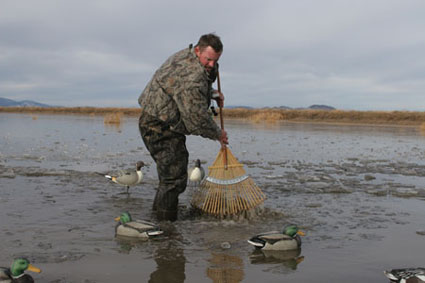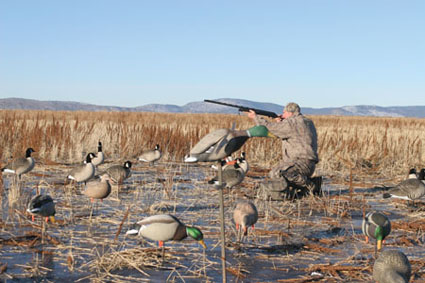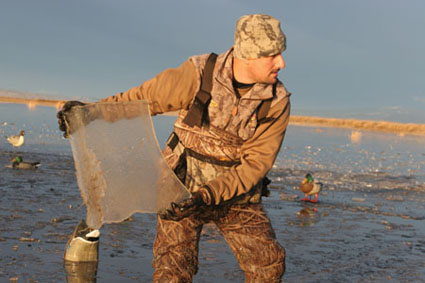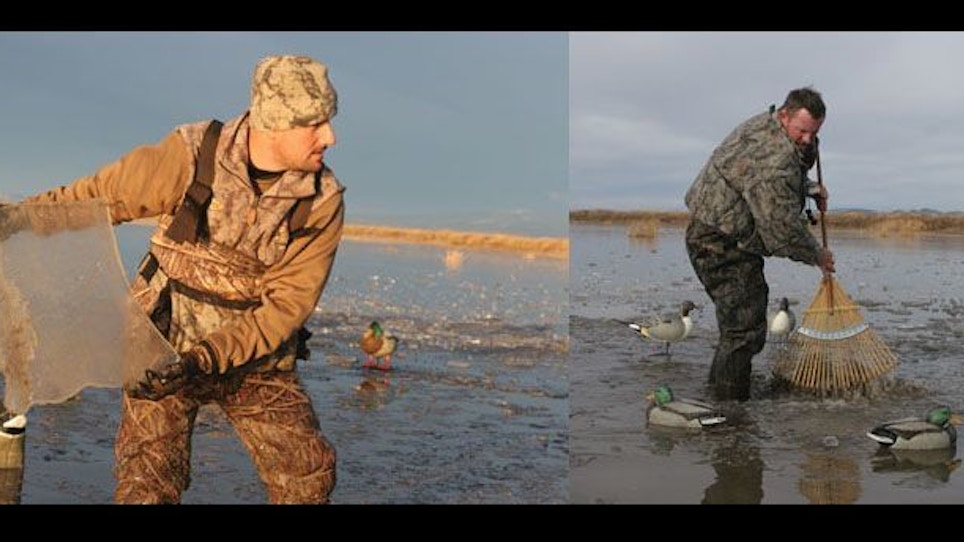 At 5 on a December morning, Jeremy McIntyre, Curt Wilson and two friends stood on the edge of a frozen marsh within a national wildlife refuge in northern California. Thirty minutes earlier, the central California residents listened as the local weather forecast told them what they already knew: It was cold, around 8 degrees, and it wasn’t going to warm up much during the entire day. A hard freeze had settled over the region a week before, and the shallow ponds of the refuge were locked under nearly two inches of ice. Despite the miserable conditions, the four hunters had complete confidence in their decision to hunt. They were prepared for the weather, and thanks to diligent scouting, they were certain the ducks would show.
At 5 on a December morning, Jeremy McIntyre, Curt Wilson and two friends stood on the edge of a frozen marsh within a national wildlife refuge in northern California. Thirty minutes earlier, the central California residents listened as the local weather forecast told them what they already knew: It was cold, around 8 degrees, and it wasn’t going to warm up much during the entire day. A hard freeze had settled over the region a week before, and the shallow ponds of the refuge were locked under nearly two inches of ice. Despite the miserable conditions, the four hunters had complete confidence in their decision to hunt. They were prepared for the weather, and thanks to diligent scouting, they were certain the ducks would show.
Find ’Em First
In fact, a pre-hunt scouting trip can make or break a day in a frozen blind, says Mark Hoke, a veteran waterfowl hunter from Laurel, MD. He’ll spend more time sitting in his truck watching ducks or geese through binoculars than he’ll actually spend in a blind during extreme cold conditions. It’s not that he doesn’t want to hunt in frigid weather. He just wants to make sure he’s on birds.
“Birds change their habits completely when cold weather sets in. The places they used to hang out and feed are either frozen or under a layer of snow, so they go to new places. They don’t always fly when it’s really cold, but they usually do. It’s often just a matter of time before they get up and move,” says Hoke. “You have to scout like it’s a new season, because cold weather changes everything.”
Sitting Tight
When they do fly, waterfowl tend to follow pretty predictable behavior patterns under extreme cold conditions. As Wilson predicted on that bitter-cold morning last December, the majority of the ducks wouldn’t show up until late morning or early afternoon.
Empty skies can fill up with birds in a matter of minutes. Hoke says geese follow the same general pattern. On frigid days, the birds will stay on the roost for several hours, sometimes all day, before flying off to feed. And when they do go to feed, it’s often for a short period of time. That’s why Hoke will stay out all day if he can stand it. He’s enjoyed some great shoots an hour before sunset as flock after flock of geese poured into a corn field long after most other hunters would have given up and headed for a warm home.
 “Sometimes, they don’t fly at all. It’s been my experience that geese fly less on cloudy days that are real cold than sunny days that are just as cold,” he notes. “Maybe the food is still frozen and they just won’t eat it unless the sun thaws it out. I’m not real sure, but I do know they go into a survival mode.”
“Sometimes, they don’t fly at all. It’s been my experience that geese fly less on cloudy days that are real cold than sunny days that are just as cold,” he notes. “Maybe the food is still frozen and they just won’t eat it unless the sun thaws it out. I’m not real sure, but I do know they go into a survival mode.”
Wilson agrees, and says ducks also sit tight until the sun gets high in the sky. And like geese, they might not fly at all. Both he and Hoke are willing to take the chance, however, because more often than not, ducks and geese will eventually get up and go.
Spread Strategies
When birds do move, it’s vital that you give them an inviting spread to come into. Big spreads with lots of motion can pull in ducks that might otherwise bypass what seems to be a perfect location, Hoke says. Although geese and ducks often have their minds made up about their destination, ducks in particular want lots of company. When they see a bunch of birds resting in one spot, they are far more likely to swing by for a look.
“Ducks and geese tend to fly in big groups, because they congregate in big groups around the available open water. They rely on each other to keep holes open as everything starts to freeze, and as the open water does freeze, they get pushed to the remaining open holes,” says McIntyre.
All three experts will utilize more resting and sleeping decoys under ice-cold conditions, because they mimic how real birds behave in cold weather. In order to conserve valuable warmth, ducks and geese will tuck their heads under a wing or on their backs, drop down onto the ice and shut down. McIntyre rings an open hole with sleepers and place a couple dozen floaters in the pocket. He also adds some full-body sleeper goose decoys nearby. They simply provide another element of realism.
“If I’m hunting a dry grain field, I’ll use more feeders, because the birds are in that field to feed,” notes Wilson. “However, if I’m hunting water, I want more sleepers, because that’s what real birds tend to do when they are sitting around a hole in the ice.”
A Hole In One
 One limiting factor, agrees Hoke and Wilson, is the time it takes to create an opening in a frozen pond or marsh. More hands makes less work, but with one or two hunters, it’s virtually impossible to bust up a large section of ice and then put out a massive decoy spread. Still, open water is key, and Wilson will take as much time as he feels is necessary to create an inviting spot for passing birds.
One limiting factor, agrees Hoke and Wilson, is the time it takes to create an opening in a frozen pond or marsh. More hands makes less work, but with one or two hunters, it’s virtually impossible to bust up a large section of ice and then put out a massive decoy spread. Still, open water is key, and Wilson will take as much time as he feels is necessary to create an inviting spot for passing birds.
“I’ll try to push larger chunks up under the edge of the opening, but that’s not always possible,” he explains. “I’m convinced it’s important to create as much open water without any obstructions in that opening as possible. If I have to throw broken ice up onto the surrounding ice, then I will.”
When the ice is too thick, Wilson and McIntyre won’t hesitate to set their decoys directly on the ice. The key, insists Wilson, is the presence of food. He’s had some great hunts on solid ice in flooded grain fields where the birds only had to pick the seed off the grain head without any effort. They don’t always need open water.
Is It Worth It?
Extreme weather can be dangerous, and Hoke always asks himself if he’s willing to endure tough conditions for a few birds. Even if he has a good feeling about the action, he analyzes the risks and makes a call based on safety. And when he goes, Hoke always prepares for the worst. Whether he’s hunting a dry corn field or big, open water, he takes a handful of emergency items in case he needs them, including a cell phone, waterproof matches, a change of clothes and an emergency blanket.
Comfort, too, is an important ingredient during an ice-cold waterfowl hunt. The most critical factor to a successful day, however, is simply mustering up the will to go, no matter how harsh the conditions. It might be cold out there, but the ducks and geese will have to fly sooner or later, and if you aren’t there, someone else just might be having the hunt of their life.






